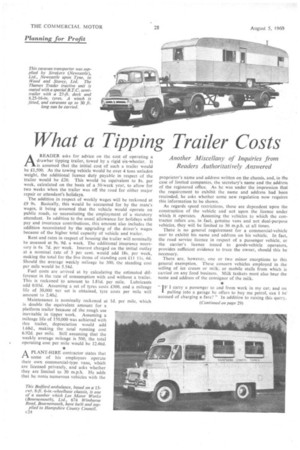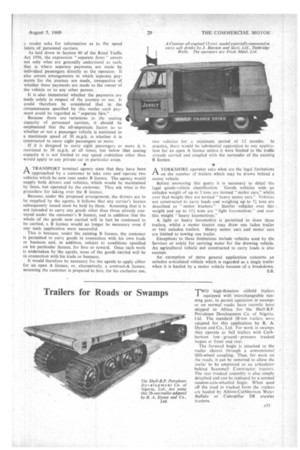What a Tipping Trailer Costs
Page 62

Page 67

If you've noticed an error in this article please click here to report it so we can fix it.
Another Miscellany of Inquiries from Readers Authoritatively Answered
AREADER asks for advice on the cost of operating a drawbar tipping trailer, towed by a rigid six-wheeler. It is assumed that the initial cost of such a trailer would be £1,500. As the towing vehicle would be over 4 tons unladen weight, the additional licence duty payable in respect of the trailer would be £20. This would be equivalent to 8s. per week, calculated on the basis of a 50-week year, to allow for two weeks when the trailer was off the road for either major repair or attendant's holidays.
The addition in respect of weekly wages will be reckoned at £9 9s. Basically, this would be accounted for by the mate's wages, it being assumed that the vehicle would operate on public roads, so necessitating the employment of a statutory attendant. In addition to the usual allowance for holidays with pay and insurance contributions, this amount also includes the addition necessitated by the upgrading of the driver's wages because of the higher total capacity of vehicle and trailer.
Rent and rates in respect of housing the trailer will nominally be assessed at 9s. 9d. a week. The additional insurance necessary is 6s 7d. per week. Interest charged on the initial outlay at a nominal rate of 3 per cent, would add 18s. per week, making the total for the five items of standing cost f11 its. 4d. Should the average weekly mileage be 500, the standing cost per mile would be 5.54d.
Fuel costs are arrived al by calculating the estimated difference in the rate of consumption with and without a trailer. This is reckoned to amount to 1.81d. per mile. Lubricants add 0.03d. Assuming a set of tyres costs £300, and a mileage life of 30,000 ner set is obtained, tyre costs per mile will amount to 2.40d.
Maintenance is nominally reckoned at Id. per mile, which is double the equivalent amount for a platform trailer because of the rough use inevitable in tipper work. Assuming a mileage life of 150,000 was achieved with this trailer, depreciation would add 1.68d., making the total running cost 6.92d. per mile. Still assuming that the weekly average mileage is 500, the total operating cost per mile would be 12.46d.
APLANT-H1RE contractor states that some of his employees operate their own commercial-type vans, which arc licensed privately, and asks whether they are limited to 30 m.p.h. He adds that he notes numerous vehicles with the proprietor's name and address written on the chassis, and, in the case of limited companies, the secretary's name and the address of the registered office. As he was under the impression that the requirement to exhibit the name and address had been rescinded, he asks whether some new regulation now requires this information to be shown.
As regards speed restrictions, these are dependent upon the construction of the vehicle and not upon the licence under which it operates. Assuming the vehicles to which the contractor refers are, in fact, genuine vans and not dual-purpose vehicles, they will be limited to 30 m.p.h. at all times.
There is no general requirement for a commercial-vehicle user to exhibit his name and address on his vehicle. In fact, the road service licence in respect of a passenger vehicle, or the carrier's licence issued to goods-vehicle operators, provides sufficient evidence to trace the owner, should this be necessary.
There are, however, one or two minor exceptions to this general exemption. These concern vehicles employed in the selling of ice cream or milk, or mobile stalls from which is carried on any food business. Milk tankers must also bear the name and address of the consignor of the milk.
IF I carry a passenger to and from work in my car, and on pulling into a garage he offers to buy me petrol, can 1 be accused of charging a fare?" In addition to raising this query. (Continued on page 29)
a reader asks for information as to the speed limits of personnel carriers.
As laid down in Section 40 of the Road Traffic Act 1956, the expression "separate fares" covers not only what are generally understood as such, that is where separate payments are made by individual passengers directly to the operator. It also covers arrangements in which separate payments for the journey are made, irrespective of whether these payments are made to the owner of the vehicle or to any other person.
It is also immaterial whether the payments are made solely in respect of the journey or not. It could therefore be considered that in the circumstances specified by this reader such payment could be regarded as "separate fare." .
Because there are variations in the seating capacity of personnel carriers, it should be emphasized that the all-important factor as to whether or not a passenger vehicle is restricted to a maximum speed of 30 m.p.h. is whether it is constructed to carry eight passengers or more.
If it is designed to carry eight passengers or more it is restricted to 30 m.p.h. at all times, but below tint seating capacity it is not limited to any speed restriction other than would apply to any private car in particular areas.
ATRANSPORT terminal agency state that they have been approached by a customer to take over and operate two vehicles which he now runs under B licence. The agency would supply both drivers and vehicles, which would be maintained by them, but operated by the customer. They ask what is the procedure for taking over the B licence.
Because, under the proposed arrangement, the drivers are to be supplied by the agents, it follows that any carrier's licence subsequently issued must be held by them. Assuming that it is not intended to carry any goods other than those already conveyed under the customer's B licence, and in addition that the whole of the goods now carried will in fact be continued to be carried, a B licence would no longer be necessary even if any such application were successful.
This is because, under the existing B licence, the customer is permitted to carry goods in connection with his own trade or business and, in addition, subject to conditions specified on his particular licence, for hire or reward. Once such work is undertaken by the agents, none of the goods carried will be in connection with his trade or business.
It would therefore be necessary for the agents to apply either for an open A licence, or, alternatively, a contract-A licence, assuming the customer is prepared to hire, for his exclusive use,
two vehicles for a minimum period of 12 months. In practice, there would be substantial opposition to any application for an open A licence unless it were limited to the traffic already carried and coupled with the surrender of the existing B licence.
AYORKSHIRE operator asks what are the legal limitations on the number of trailers which may be drawn behind a motor vehicle.
Before answering this query it is necessary to detail the legal goods-vehicle classification. Goods vehicles with an unladen weight of up to 3 tons are termed "motor cars," whilst over that weight they are termed " heavy motor cars." Vehicles not constructed to carry loads and weighing up to 71 tons are described as " motor tractors." Similar vehicles over this weight and up to 111 tons are " light locomotives" and over this weight " heavy locomotives."
A light or heavy locomotive is permitted to draw three trailers, whilst a motor tractor may draw one laden trailer or two unladen trailers. Heavy motor cars and motor cars are limited to towing one trailer.
Exceptions to these limitations include vehicles used by the Services or solely for carrying water for the drawing vehicle. An agricultural vehicle not constructed to carry loads is also exempt.
An exemption of more general application concerns an unladen articulated vehicle which is regarded as a single trailer when it is hauled by a motor vehicle because of a breakdown. S.B.




































































































